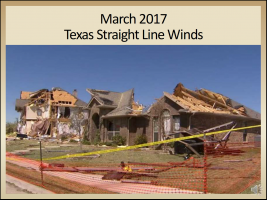-
Welcome to the new and improved Building Code Forum. We appreciate you being here and hope that you are getting the information that you need concerning all codes of the building trades. This is a free forum to the public due to the generosity of the Sawhorses, Corporate Supporters and Supporters who have upgraded their accounts. If you would like to have improved access to the forum please upgrade to Sawhorse by first logging in then clicking here: Upgrades
You are using an out of date browser. It may not display this or other websites correctly.
You should upgrade or use an alternative browser.
You should upgrade or use an alternative browser.
Straight Line Winds
- Thread starter jar546
- Start date
Msradell
Sawhorse
What part of Texas was this?
Assuming it's not along the coast I wonder if the design requirements for hurricane protection would also work for straight-line wind protection. It seems like they are both very similar and quite a bit different from the effects of tornadoes.
Assuming it's not along the coast I wonder if the design requirements for hurricane protection would also work for straight-line wind protection. It seems like they are both very similar and quite a bit different from the effects of tornadoes.
ICE
Oh Well
What was the wind speed?
jar546
Forum Coordinator
What was the wind speed?
95-100MPH
Paul Sweet
Sawhorse
Was that the average speed, or 3-second gust? A 90 MPH (working stress design) gust is the minimum for most of the country, and higher near the coast or mountain passes. A factor of safety of 2 is built into the code, so it should take almost a 130 MPH gust to cause structural failure. Shingles & siding will probably start blowing off at much lower speeds.
jar546
Forum Coordinator
They come from microbursts so I would think they are not sustained windsWas that the average speed, or 3-second gust? A 90 MPH (working stress design) gust is the minimum for most of the country, and higher near the coast or mountain passes. A factor of safety of 2 is built into the code, so it should take almost a 130 MPH gust to cause structural failure. Shingles & siding will probably start blowing off at much lower speeds.
The Factor of safety is less than two, probably closer to 1.7, and is intended to address a number of concerns so not all of it is available to deal with higher wind speeds. Also the wind pressure increases with the square of the velocity. Remember the strength of wood of a given grade varies considerably.
Did they use the right grade of lumber? Were all the needed fasteners installed?
It is even possible that the members may have been sized to resist the wind but the failure could have been because some roofing or other element was not properly installed. Once part of the roof failed it allowed adjacent areas to fail at lower wind speeds..
Did they use the right grade of lumber? Were all the needed fasteners installed?
It is even possible that the members may have been sized to resist the wind but the failure could have been because some roofing or other element was not properly installed. Once part of the roof failed it allowed adjacent areas to fail at lower wind speeds..
jar546
Forum Coordinator
The Factor of safety is less than two, probably closer to 1.7, and is intended to address a number of concerns so not all of it is available to deal with higher wind speeds. Also the wind pressure increases with the square of the velocity. Remember the strength of wood of a given grade varies considerably.
Did they use the right grade of lumber? Were all the needed fasteners installed?
It is even possible that the members may have been sized to resist the wind but the failure could have been because some roofing or other element was not properly installed. Once part of the roof failed it allowed adjacent areas to fail at lower wind speeds..
Great questions. Seeing how 115mph is becoming the standard with ICC codes, previously 90mph, I fail to see how any of the construction in the photo met any standard other than the good ole' boys standard, hence the results in the photo.
my250r11
Sawhorse
It is Texas, they don't like rules & laws. Most places only have code just in major cities. Last I heard they don't require any kind of licensing. We get a lot of contractors here from Texas and a few are good, the rest are very questionable.Great questions. Seeing how 115mph is becoming the standard with ICC codes, previously 90mph, I fail to see how any of the construction in the photo met any standard other than the good ole' boys standard, hence the results in the photo.
Last edited:
ADAguy
Registered User
It is Texas, they don't like rules & laws. Most places only have code just in major cities. Last I heard they don't require any kind of licensing. We get a lot of contractors here from Texas and a few are good, the rest are very questionable.
Sure that wasn't a tornado?
jar546
Forum Coordinator
Was not a tornado. This was a straight line wind as investigated by FEMA and NOAA. I have plenty of tornado photos which is why I chose this one. These are always a threat anywhere in the US.Sure that wasn't a tornado?

